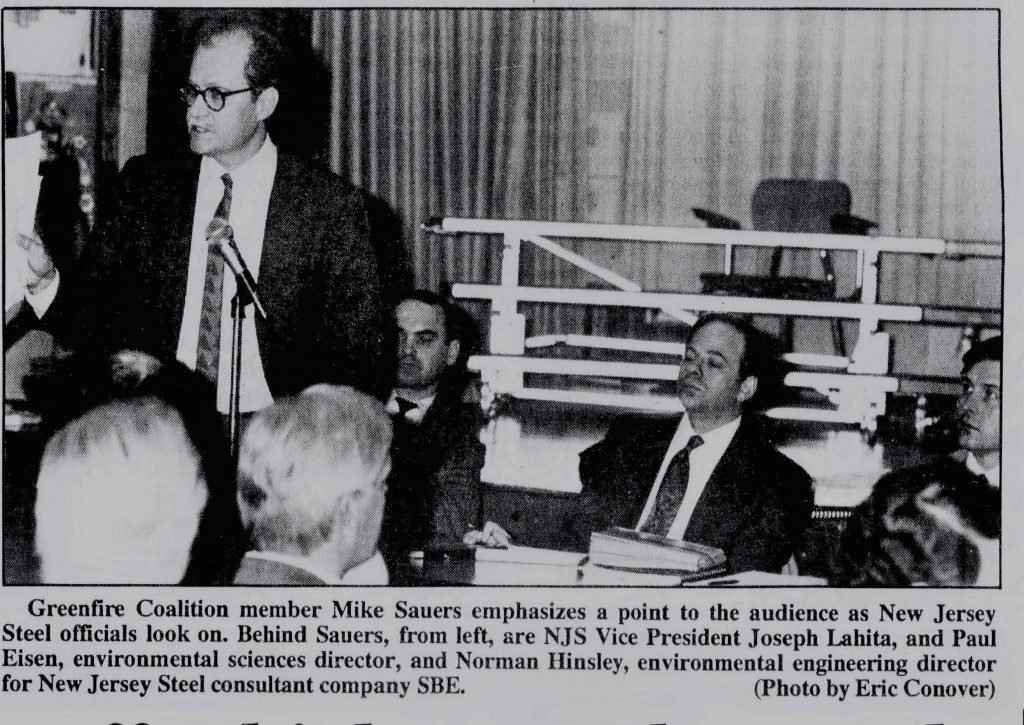Mike Sauers
Northeastern Pennsylvania has a very checkered history regarding environmental stewardship. After all, the area was settled and developed based on furs, logging, railroads and the mining of anthracite coal. This resulted in the abuse of animals, labor, land and water. The scars of those activities remain to this day. The post-mining period (1945 -2021) has centered on questionable economic development emphasizing sprawling industrial parks.
However, there was a period during which a small but committed group of community based organizations and individuals banned together to address a myriad of environmental, community and economic development problems that challenged the area. This group called itself, Greenfire Coalition.
Greenfire was a regional (Carbon, Columbia, Lackawanna, Luzerne and Schuylkil Counties), non-profit, umbrella organization headquartered in Hazleton, PA. It was run entirely by volunteers and completely self-funded. The primary purpose of Greenfire was to insert a robust, alternative voice into issues that directly impacted the quality of life in the area communities. This was accomplished via organizing and networking, public education and community service, lobbying on all government levels, testifying at public hearings, establishing open lines of communication, providing support and organizational skills to grassroots community groups and, sometimes, direct action.
Throughout the 1980’s and early 1990’s, the Greater Hazleton Area specifically and Northeastern Pennsylvania generally were plagued with a daunting variety of environmental, quality of life and economic development problems. Greenfire recognized that scarred and abandoned mineland, acid mine drainage, numerous named and unnamed Superfund sites, unlined landfills containing hazardous waste, a nuclear power plant storing spent fuel rods, poorly planned industrial parks, illegal/midnight dumping and industries that emitted significant quantities of carcinogenic toxins were issues that needed to be addressed. Additionally, there were proposals for mega landfills, medical waste incinerators, hazardous waste incinerators, contaminated soil incinerators, sewage sludge composting, co-generation plants and polluting industries. Complicating the above was a leadership structure that chose to minimize the problems, marginalize criticism and refrain from a full throated discussion of environmental, community and economic development issues.
During this time there were individuals who attempted to address these issues. Some of them formed community organizations. In 1990, environmental and community leaders came together and the seed was planted for an umbrella organization. While not carrying the Greenfire banner the group organized and worked together culminating in an Earth Day celebration unlike any the area had ever seen. This educational celebration took place in Hazleton’s Indigenous Peoples’ Park (Columbus). Hundreds of area citizens volunteered, scores of community organizations participated and thousands attended. It was an important success. The Greenfire Coalition was born.
From 1990 until 1995, Greenfire conducted a dynamic, community based effort to address the above environmental concerns and offer an alternative view for economic and community development. The following is a list of actions taken by Greenfire. While not complete, it provides a clear representation of the work Greenfire engaged in.
Organizing and Networking
Greenfire organized and facilitated a platform (Greenfire Coalition) for idea sharing and generating support among individuals/groups in a five county area. While each individual/group was independent and capable of leadership, they drew strength as part of Greenfire Coalition (1990-1995). The coalition brought together approximately 25 groups.
Community Education/Service Projects
Hosted and organized Earth Day Celebrations in Hazleton (1990, 1991, 1992, 1993)
Hosted Greenpeace visit in Hazleton (1991)
Hosted Clean Water Action visit in Hazleton (1991)
Hosted Waste Reduction Seminar in Hazleton (1991)
Hosted Composting/Waste Reduction Workshop in Hazleton (1991)
Conducted Environmental Entrepreneurial Workshop at Hugh O’Brien Leadership Conference in Harrisburg (1991)
Hosted Environmental Shopping Workshop in Harrisburg (1992)
In partnership with Lower Anthracite Project conducted an Environmental Stewardship, Economic Development & Leadership Conference in Hazleton (1993)
Conducted an assertive public education campaign through local media (TV, radio, newspapers, talk shows, press conferences, public forums and direct action (1990-1995)
In partnership with Lower Anthracite Project and the Wildlands Conservancy established the Middle Anthracite Watershed Association (1994)
Brought to the area nationally recognized environmental experts including Lois Gibbs, John Narr, Steven Rothstein, Michael Kinsely, Dr. Paul Connet, Dr. Judith Johnsrud, Rick Makula, Don Heinzelman and Barry Commoner
Lobbying, Testifying and Communication Efforts
Opened lines of communication with local, county, state and federal elected representatives and administrative agencies. Did the same with local and regional economic development groups
Lobbied all government levels regarding economic development and waste management strategies
Lobbied local and regional economic development groups regarding the recruitment of sustainable, clean industry that payed a living wage
Offered testimony and support to groups regarding Superfund sites including McAdoo Associates (Kline Township), C&D Recycling (Foster Township), Valmont TCE Site (Valmont Industrial Park), Tonalli Corp. (Nesquehoning), Palmerton Zinc Pile (Palmerton), Eastern Diversified Metals (Hometown), Keystone Sanitary Landfill (Luzerne County) and Hazleton City Landfill (Hazleton)
Lobbied EPA regarding the establishment of industrial park rangers to monitor odor and pollution complaints in Valmont and Humbolt Industrial Parks.
Lobbied the Greater Hazleton Sewer Authority regarding its impact on the Nescopeck Creek, Susquehanna River and Chesapeake Bay
Lobbied local, state, and federal governments regarding the acid mine drainage from the Jeddo Mine Tunnel and otheer locations
Testified at the House Republican Policy Committee Task Force on the Environment in Pottsville (1992)
Direct Action Efforts
Appealed in the Court of Common Pleas of Luzerne County decisions by Hazle Township Zoning Hearing Board regarding New Jersey Steel Corporation. This helped defeat the NJS proposal (1992)
Picketed the offices of CANDO regarding New Jersey Steel and other industrial development issues. This was never done before or since.
Supported S.O.L.E. II in its successful effort to stop a mega landfill in Foster Township
Conclusion
What I have provided is a skeletal representation of the work done by Greenfire. As I researched, I was astonished by the depth and quality of the work done by the groups and individuals comprising the Coalition. I tip my hat to those folks, both living and deceased, who put forth a herculean effort to address critical issues affecting their communities. To fully research the Greenfire Coalition simply go on Newspapers.com or contact this author.

